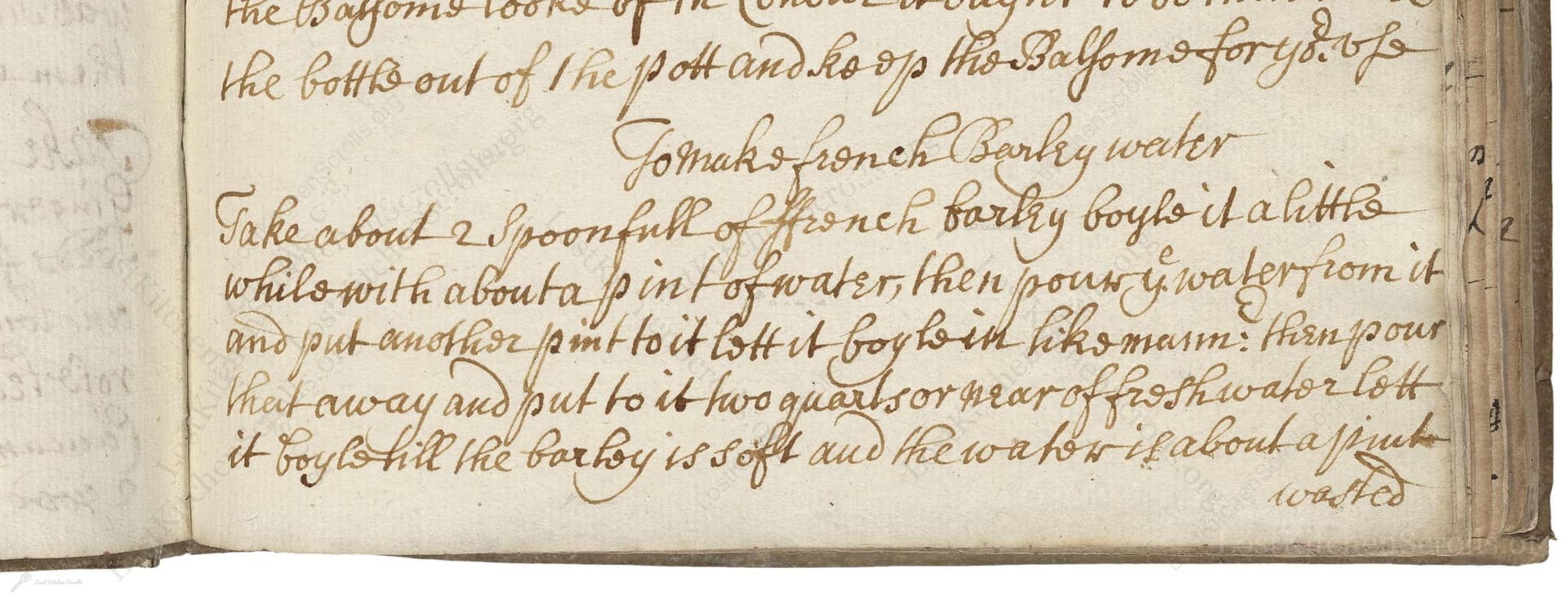Tomake French Barley Water
From the treasured pages of Cookbook 1700 - 1775
Unknown Author

Tomake French Barley Water
"Take about 2 Spoonfull of french barley boyle it a little whilso with about a pint of water, then pour yor water from it and put anothor pint to it lett it boyle in like mann: then pour that away and put to it two quarts or near of fresh water lett it boylo till the barley is soft and the water is about a pinte wasted"
Note on the Original Text
The recipe is written in the abrupt, shorthand style typical of 18th-century manuscript cookery, with little in the way of precise measurement or detailed instruction. The spelling reflects the fluidity of written English at the time (e.g., ‘boyle’ for ‘boil’, ‘pinte’ for ‘pint’, ‘lett’ for ‘let’), and standard units like ‘pint’ have been interpreted as roughly 500 ml in today’s terms. Notably, repeated boiling and discarding of the barley's cooking water was commonplace, reflecting both culinary practice (to purify and refine the flavor) and a general approach to making simple, restorative drinks.

Title
Cookbook 1700 - 1775 (1738)
You can also click the book image above to peruse the original tome
Writer
Unknown
Era
1738
Publisher
Unknown
Background
Step back into the savory world of the early 18th century with this enchanting culinary manuscript, brimming with recipes, household hints, and the elegant flavors that defined an era of rich dining and refined taste.
Kindly made available by
Folger Shakespeare Library
This recipe comes from an English manuscript dated somewhere between 1700 and 1775. French barley refers to a refined, polished barley popular in early modern Europe, believed to be more wholesome and easier to digest. Barley water was a favored beverage of the period—both a gentle thirst-quencher and a home remedy for the sick or those in convalescence, appreciated for its mild flavor and reputed health benefits. At a time when water purity was uncertain and sophisticated soft drinks were yet to be invented, barley water represented both simple luxury and practical nourishment in households from humble to genteel.

In the original era, cooks would have used a hearth or open fire, with sturdy iron or brass pots for boiling. Water would have been fetched from a well or pump, and barley carefully picked over before use. Spoons for measuring would have been approximate, and straining the barley water was usually done through a cloth or simple sieve.
Prep Time
10 mins
Cook Time
1 hr
Servings
4
We've done our best to adapt this historical recipe for modern kitchens, but some details may still need refinement. We warmly welcome feedback from fellow cooks and culinary historians — your insights support the entire community!
Ingredients
- 1 oz pearl barley (about 2 tablespoons, substitute for historical ‘French barley’)
- 2 quarts fresh water
Instructions
- Begin by taking about 2 tablespoons (roughly 1 ounce) of pearl barley, which is a common modern substitute for ‘French barley,’ and place it in a medium saucepan.
- Add 2 cups (about 16 fluid ounces) of cold water and bring it to a gentel boil for a few minutes.
- Discard this water to remove surface starches and impurities.
- Add another 2 cups of fresh water to the barley and bring it to a boil again, repeating the prosess, then discard this second water as well.
- Finally, pour approximately 8 cups (about 2 quarts) of fresh water over the barley.
- Bring it up to a gentle boil, then reduce the heat and simmer until the barley is soft and the total liquid has reduced by about 2 cups (to about 6 cups remaining).
- Strain, cool, and serve the barley water as a refreshing and restorative drink.
Estimated Calories
30 per serving
Cooking Estimates
You will spend a few minutes rinsing the barley, then simmer it for about an hour. This recipe makes enough for about 4 servings, and each serving has very few calories.
As noted above, we have made our best effort to translate and adapt this historical recipe for modern kitchens, taking into account ingredients nowadays, cooking techniques, measurements, and so on. However, historical recipes often contain assumptions that require interpretation.
We'd love for anyone to help improve these adaptations. Community contributions are highly welcome. If you have suggestions, corrections, or cooking tips based on your experience with this recipe, please share them below.
Join the Discussion
Rate This Recipe
Dietary Preference
Main Ingredients
Culinary Technique
Occasions

Den Bockfisch In Einer Fleisch Suppen Zu Kochen
This recipe hails from a German manuscript cookbook compiled in 1696, a time whe...

Die Grieß Nudlen Zumachen
This recipe comes from a rather mysterious manuscript cookbook, penned anonymous...

Ein Boudain
This recipe comes from an anonymous German-language manuscript cookbook from 169...

Ein Gesaltzen Citroni
This recipe, dating from 1696, comes from an extensive anonymous German cookbook...
Browse our complete collection of time-honored recipes



